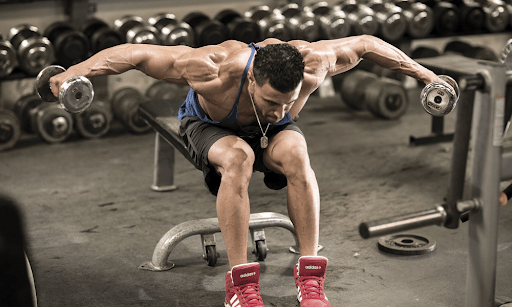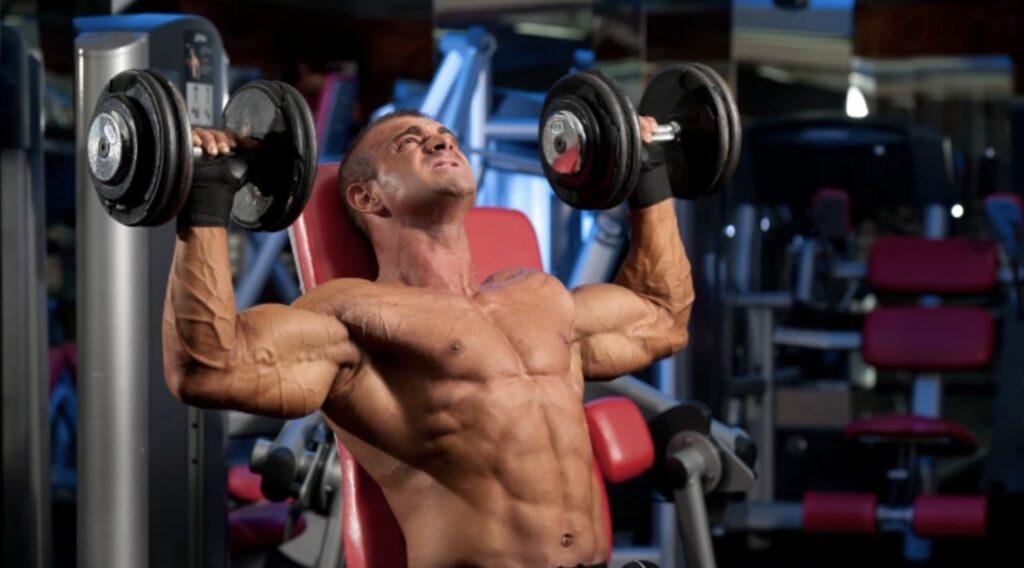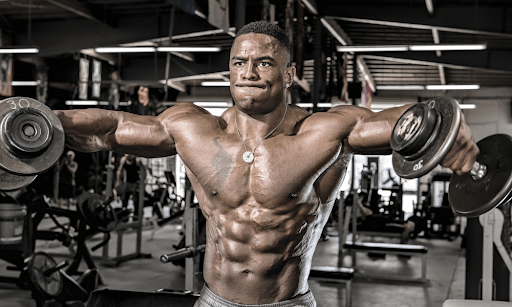01dragonslayer
Administrator

Whether you are focusing on training a specific muscle group or depending on a total body approach, your shoulder muscles are involved. They are involved in chest workouts that feature pressing such as bench presses and barbell squats.
While shoulders are involved in most exercises, that doesn’t mean you shouldn’t include shoulder training in your workout routine. Your shoulder is an intricate and versatile joint that must be trained to build muscles and strength and create an impressive physical appearance.
This article dives into shoulder development, exploring a range of exercises and offering valuable tips to help you sculpt strong and visually appealing shoulders.
IMPORTANCE OF SCULPTED SHOULDERS
Having sculpted shoulders goes beyond aesthetics; it offers numerous fitness and health benefits, such as the following.
INJURY PREVENTION
The shoulder joint is one of the most mobile and complex joints in the body, allowing a wide range of motion. However, this mobility also makes it susceptible to injuries like dislocations and rotator cuff tears when working out in the gym.
Sculpted shoulder muscles, including the deltoids and rotator cuff muscles, help stabilize the shoulder joint, reducing the risk of injury and improving overall shoulder function.
Additionally, balanced shoulder development provides better support for your upper body preventing muscle imbalances such as shoulder impingement, rotator cuff strains, and instability, possibly leading to overuse injuries.
IMPROVED POSTURE AND ALIGNMENT
Many individuals struggle with rounded shoulders and a forward head posture due to sedentary lifestyles.
Well-developed shoulders help counterbalance these postural imbalances by strengthening the muscles that retract and depress the shoulder blades, contributing to better posture and upper body alignment.
ENHANCED ATHLETIC PERFORMANCE
Sculpted shoulders are essential for athletes, including bodybuilders. They generate power and contribute to upper body mobility and agility, improving your performance and preventing injuries.
Strong shoulders with good flexibility and mobility also allow for a broader range of motion in the upper body. This enables you to do activities requiring a full range of motion, such as overhead movements.
IMPROVED DAILY ACTIVITIES
Strong shoulders are essential for everyday activities that involve the upper body.
Whether lifting heavy objects, carrying groceries, playing with your children, or participating in recreational sports, well-developed shoulders provide strength, stability, and mobility, making everyday tasks and gym activities safer and more efficient.
FUNCTIONAL STRENGTH AND STABILITY
The shoulders are involved in numerous daily activities and movements, such as lifting, pushing, pulling, and carrying objects.
Well-developed shoulders provide a solid foundation of strength and enhanced stability for functional movements.

TOP 10 SHOULDER WORKOUTS FOR BUILDING YOUR MUSCLES
1. ARNOLD PRESS
Arnold Press is a variation of the overhead press named after bodybuilding icon Arnold Schwarzenegger. It targets all three heads of the deltoid (front, side, and rear) as well as the triceps.
Arnold press exercise provides a greater range of motion and rotation, increasing tension time which stimulates the entire shoulder muscle growth. It also helps develop stability and coordination in the shoulder joint.
You can do Arnold press from a standing, seated or kneeling position. In this case, we will do a kneeling Arnold press to avoid back pain.
HOW TO DO:
- Kneel on the floor with your core and glutes tightened up. Hold dumbbells at shoulder height, palms facing your body.
- Press the weights overhead while simultaneously rotating your palms outward from your chest. At the top of the movement, your palms should face forward.
- Reverse the motion on the way down the starting position.
2. BARBELL OVERHEAD PRESS
The overhead barbell press is a compound exercise that targets the anterior deltoids (front delts) and medial deltoids (side delts). It also engages the triceps and upper chest muscles.
This exercise helps build overall shoulder strength, size, and stability, which is suitable if you want stronger and boulder shoulder muscles.
Although the barbell overhead press may seem easy, it needs much practice and experience to perform well. Start with lighter weights to practice proper form and gradually increase the weight as you become comfortable and stronger.
HOW TO DO:
- After warming up your wrist, stand with your feet shoulder-width apart directly under the power bar and grip the barbell with an overhand grip.
- Lift the barbell to shoulder level, resting it on the front shoulders. Ensure your elbows and forearms are slightly in front of the barbell (stacked vertically).
- Put the weight on the heel of your palm and press the weight overhead until your arms are fully extended.
- Lower the weight back to shoulder level in a controlled manner. Repeat the movement for the desired number of repetitions.
3. DUMBBELL SHRUGS
Dumbbell shrugs target the trapezius muscles.
This exercise builds strong and defined traps, enhancing the overall appearance of the shoulders, neck, and upper back. It also contributes to better posture and spinal alignment.
HOW TO DO:
- Hold a dumbbell in each hand, palm in a neutral position, arms straight by your sides and elbows fully extended.
- With your core and glutes engaged and neck in a neutral position, shrug your shoulders upward, squeezing the traps,
- Hold for a second, and then lower your shoulders back down slowly with control.
4. PUSH PRESS
The push press is a dynamic, explosive movement that uses leg drive to assist in pressing weight overhead. It primarily targets the deltoids (all three heads) and the triceps.
Push press exercise lets you lift heavier weights using leg power, promoting broad shoulder and upper body strength. It also enhances explosive ability targeting the fast-twitch muscle fiber with the most potent muscle growth.
Moreover, the workout target multiple muscles, and it is versatile. You can do it unilaterally at home or the gym to build shoulder stability, strength and muscle endurance.
HOW TO DO:
- Start by standing on your feet, shoulder wide apart, with the barbell on your shoulders, arms bent, and palms facing forward. Ensure your knee is slightly bent.
- Quickly extend your legs and drive the weight overhead while using your shoulders and triceps to complete the press. Control the descent back to your shoulders and repeat.
5. SEATED DUMBBELL SHOULDER PRESS
The seated dumbbell press is similar to the military press but performed with dumbbells instead of barbells. It primarily targets the deltoid muscles (all three heads), triceps, and upper back muscles for muscle growth.
Seated dumbbells shoulder press allows you to move your arm independently, which addresses any muscle imbalances improving the balance between the left and right shoulders.
Furthermore, the exercise provides stability and a more natural range of motion that maximizes muscle growth and strength.
HOW TO DO:
- Sit on a bench with a backrest, holding a dumbbell in each hand at shoulder height, palms facing forward.
- Press the dumbbells upward until your arms are fully extended, keeping the weights balanced and aligned with your shoulders.
- Slowly lower the dumbbells back to shoulder level and repeat the movement for the desired number of repetitions.
6. SEATED FLOOR LATERAL RAISE
The seated floor lateral raise is an effective isolation exercise that targets the side (lateral) deltoid muscles. It is more effective than traditional lateral raise as it eliminates any movement from the hips and arm that might interfere with its correct performance.
Seated floor lateral raise isolates and develop the lateral deltoids responsible for the shoulders’ width and roundness. This enhances shoulder width and creates a more sculpted appearance. The exercise also improves shoulder stability and strengthens the muscles involved in shoulder abduction.
HOW TO DO:
- Start by sitting straight up on the floor with your legs extended in front of you.
- Hold a dumbbell in each hand, palms facing inward. Ensure your core is tight.
- Keep your arms slightly bent and use your shoulder (not traps) to raise the dumbbells to your sides until they parallel the floor.
- Slowly lower the dumbbells back to the starting position and repeat for the desired number of repetitions.

7. LATERAL RAISE
Lateral raise is an excellent isolation workout that works on the medial deltoids (side delts) to develop broader shoulders and enhance the appearance of shoulder width. It also improves shoulder stability and assists in overhead movements.
Do it as the first workout if you are training to add depth to your medial delts and last to work out your rear delts, as they need more work.
HOW TO DO:
- Stand with dumbbells in hand at your hips, glutes squeezed, core and shoulder blades tight. Shoulders slightly bend.
- Lift the weights to your sides until your arms parallel the ground and your wrists below your shoulders.
- Lower the weight slowly while controlling the movement.
8. INCLINED BENCH PRESS
The inclined bench press is a compound movement that targets the upper pectoralis significant muscles and anterior deltoids, triceps, and core and upper back muscles for stability.
The inclined bench press strengthens the upper chest muscles and activates the front deltoids, contributing to balanced shoulder development.
HOW TO DO:
- Lie on an incline bench set at a 30-45-degree angle, holding a barbell with a grip slightly wider than shoulder-width.
- Lower the barbell to your upper chest, flaring your elbows to the sides.
- Pause and push the barbell back up to the starting position by extending your arms while maintaining control and stability throughout the movement.
- Repeat for the desired number of repetitions.
9. FACE PULLS
Face pulls involve pulling a cable attachment towards your face, targeting the rear delts and upper back muscles.
Face pulls are highly effective for improving posture, shoulder stability and strengthening the often-neglected rear deltoids. It helps counterbalance the effects of excessive chest training and anterior shoulder work, promoting balanced shoulder development.
HOW TO DO:
- Set up a cable machine with a rope, resistance band or dual handles attached at chest height.
- Stand with your feet shoulder-width apart, facing the machine and grasp the handles, the or band with an overhand grip, palms facing downward.
- Pull the rope or band towards your face while keeping your elbows high and wide, squeezing your shoulder blades together.
- Pause briefly at the movement’s peak and then slowly return to the starting position. Repeat for the desired number of repetitions.
10. FRONT RAISE
The front raise is a shoulder isolation exercise that involves raising a weight or dumbbell in front of your body with your arms extended.
The workout targets the anterior (front) deltoids and secondary involvement from the lateral deltoids and upper chest muscles.
Front raises develop and strengthen the front of the deltoid shoulder muscles, enhancing shoulder aesthetics and providing stability during pressing movements. Additionally, it improves shoulder mobility and functional strength.
HOW TO DO:
- Stand with your feet shoulder-width apart, holding a dumbbell in each hand. Keep your core, glutes, and shoulder blades engaged.
- Keeps your arms extended and your palms facing your thighs.
- Squeeze your shoulders and slowly lift the dumbbells forward, ensuring a controlled movement until your arms are parallel to the ground.
- Hold for a brief pause, and then lower the dumbbells back down to the starting position. Repeat for the desired number of repetitions.
CONCLUSION
Sculpting strong shoulders is a journey that requires dedication, proper technique, and a well-rounded approach. You can enhance your shoulder development by incorporating the right exercises, such as face pull, front raises, and lateral raises and following the strategies outlined here.
Sculpting strong shoulders is not only about achieving a visually impressive physique but also about enhancing your overall strength, posture, and functional abilities.
Begin your journey towards sculpting strong shoulders today with these shoulder workouts.


